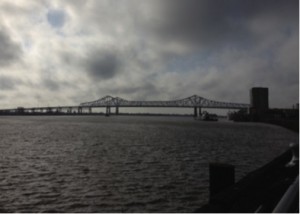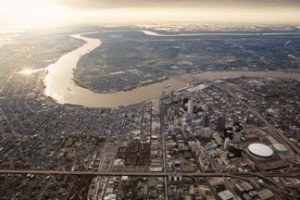From January 22 to 26, 2012, scientists from around the world gathered for the American Meteorological Society annual meeting, which was held in New Orleans, Louisiana. Scientists from the GLOBE Program stayed next to the beautiful Mississippi River.
The Mississippi River is the lifeblood of New Orleans and has so impacted the city that the city was actually developed around it. The first buildings were constructed around the river edge, which has the highest ground, and now gives the city a crescent shape if you were looking down on it from above. This is why the city is sometimes referred to as the Crescent City.
The Mississippi River is the largest river in North America and travels over 4000 km from Minnesota south to Louisiana where it drains into the Gulf of Mexico. This river, like all rivers, is living and the health of the river can be measured in several ways. This is similar to how you can use GLOBE protocols to measure environmental phenomena in different ways, depending on what information you want to discover.
Here in New Orleans we see the river every day as we walk to the scientific conference. The very presence of being in New Orleans triggers reminder of Hurricane Katrina in 2005, which was the worst hurricane experienced by the city and the costliest and deadliest hurricane to impact the United States. You may be surprised to learn that the impacts of hurricanes and the health of the river are closely related.
All along the Mississippi River, the land is very fertile and there is abundant agriculture. The natural flooding of the river on to the flood plain over hundreds of years has deposited nutrients and minerals into the soil resulting in soil that is very fertile. However, the agriculture is impacting the river because runoff from these agricultural areas contains excess amounts of nitrogen and phosphorus – they are changing the chemical makeup of the river. As the water flows downstream and into the Gulf of Mexico, the pollutants accumulate at the mouth of the river and have created a “dead zone” just off the Delta, which adversely impacts aquatic life. An aquatic dead zone is an area with very low oxygen content; we say that it is hypoxic. The Gulf of Mexico is not the only dead zone. This image produced by NASA shows dead zones in several locations around the world with large concentrations along the eastern seaboard of the United States and a second area in northern Europe.
Do you live near one of these dead zones? If you are near an aquatic dead zone or live near any body of water, use the GLOBE hydrology protocols to investigate the quality of the water. Either add a comment or send us an email to let us know what you find!
-JSM




The concentration of dead zones on the eastern seaboard of the US and in Northern Europe highlights another negative impact we are having on the aquatic environments around our coastlines. Is this creation of hypoxic areas purely due to N and P run-off or is there a contribution from sewage, etc.?
Sewage can contribute to hypoxic areas. Chemical fertilizers are considered the main anthropogenic cause of aquatic dead zones, but definitely are not the only contributor.
When do we understand. Aquatic environments are important for our life. We can’t go on like this.